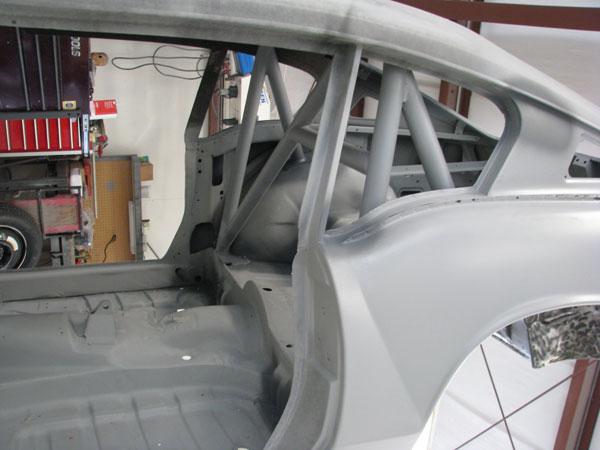i love it! how do i find my own storied race car? how did you find this group 44 car? was it outrageously expensive because of it's heritage?


We have our chassis and all our black parts back from the powder coaters. We went with a semi-gloss black that seemed to match the Triumph frame coating perfectly. East Coast Ornamental did a beautiful job; they didn’t lose a single piece and performed the work quickly. Our total bill for sandblasting and powder coating was $400. Folks, this is way cheaper, easier and more durable than painting.
Meanwhile, back at The Body Werks, Tom Prescott and his crew were going hard at it. Tom hammered and dollied out most of the dings and dents from the floor of the GT6, all while wondering if the damage occurred at Daytona, Marlboro or Road Atlanta. With this much history, it hurts to change anything. However, we felt we needed to hammer out some of the results of these off-course excursions. Gary Hunter from our office stopped by to help wire brush the bottom of the car.
A while back, we made the decision to remove the non-original cage. We were a bit hesitant due to rumors that Reeves Calloway built the cage, but it turns out we made the right decision. A friend of ours ran into Reeves Calloway, and he denied ever having built a cage for this car; apparently one of the previous owners had created this urban legend. Our photos clearly show that the car had a four-point bar when it was in the ARRC winner’s circle at Daytona in 1969, so we went back to that style of roll bar. For additional safety, we welded in a diagonal cross brace and a harness bar.
We had tried modifying and fitting an Autopower roll bar we had from a past Triumph Spitfire project, but it was too wide to fit in the GT6. So, we took some measurements and called Autopower. They quickly and cheaply bent us up a main hoop and threw in the extra pieces so we could cut and weld them in correctly—you want your harness bar to be below your shoulders, but only by a few inches.
While sitting in the car, we measured the correct height for the bar, tacked everything together, then pulled out the entire assembly. We completely seam welded the roll bar together, then put it back into the car for welding in place.
We have been gathering parts for our project. While the body was at the body shop and the frame and suspension components were at the powder coaters, we went through all of the remaining components—along with our notes—and placed a rather large order with SpitBits. They had every single piece we needed in stock—except for the wooden dashboard, which is made to order. On top of that, they were very cordial and had the order at our door in less than a week. It’s nice to deal with a business that has the inventory, prices, shipping and online ordering capabilities of a big company but the personal service of a small company. The owner, Nigel Cosh, usually picks up the phone himself.
For the stuff we couldn’t get from SpitBits, we turned to local sources. Our radiator, for example, was custom-built by Group 44 from Corvette parts—and it’s huge compared to a GT6 radiator. We sent it down to Robbins Radiator Works in Daytona Beach for a recore. This shop has been a fixture in our area’s automotive scene since 1922, and it’s surprising how many local Daytona Continental entrants we have spied through sourcing radiator work from this company.
i love it! how do i find my own storied race car? how did you find this group 44 car? was it outrageously expensive because of it's heritage?
Displaying 1-2 of 2 commentsView all comments on the CMS forums
You'll need to log in to post.